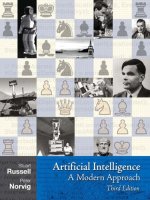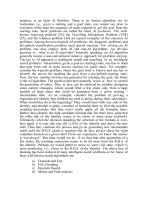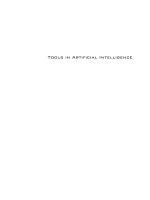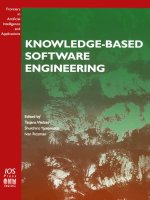Artificial intelligence, applied in agriculture
Bạn đang xem bản rút gọn của tài liệu. Xem và tải ngay bản đầy đủ của tài liệu tại đây (442.95 KB, 7 trang )
International Journal of Mechanical Engineering and Technology (IJMET)
Volume 10, Issue 12, December 2019, pp. 253-259, Article ID: IJMET_10_12_028
Available online at />ISSN Print: 0976-6340 and ISSN Online: 0976-6359
© IAEME Publication
ARTIFICIAL INTELLIGENCE, APPLIED IN
AGRICULTURE
Sánchez Céspedes, Juan Manuel
Profesor Asociado. Facultad de Ingeniería.
Universidad Distrital Francisco José de Caldas.
Espinosa Romero, Ana Patricia
Directora Programa de Ingeniería Ambiental. Facultad de Ingeniería.
Universidad de La Guajira.
Rodríguez Miranda, Juan Pablo
Profesor Titular. Facultad del Medio Ambiente y Recursos Naturales.
Universidad Distrital Francisco José de Caldas.
ABSTRACT
The objective of this paper is to review how artificial intelligence (AI) tools have
helped the agricultural sector. For this, a search process was carried out in the main
scientific repositories. The investigations were then classified according to the
Artificial Intelligence technique applied. At the end, it concludes, the great utility of AI
tools in the agricultural sector, especially in determining the use of land, water and
agricultural production.
Keywords: Artificial intelligence, agriculture, Agent-based models, cellular
automaton, genetic algorithms, artificial neural networks, fuzzy logic
Cite this Article: Sánchez Céspedes, Juan Manuel, Espinosa Romero, Ana Patricia,
Rodríguez Miranda, Juan Pablo, Artificial Intelligence, Applied in Agriculture.
International Journal of Mechanical Engineering and Technology 10(12), 2019, pp.
253-259.
/>
1. INTRODUCTION
Artificial intelligence is an area of engineering that has had great growth since the 21st
century, which seeks to emulate the mental processes that the human being performs, how to
reason to solve problems. Artificial Intelligence (AI) has been used in many areas of
knowledge, for example in business intelligence (Universidad de Catalunya, 2010). In the
financial sector it was applied in (Cisneros, 2013) and (López Rodríguez & Silega Martínez,
2015). For the optimization of production processes such as the one carried out by (Larrañaga,
Zulueta, Elizagarate, & Bernardo, 2011). Also in human resource selection processes (Torres
et al., 2014). In addition, they have worked on environmental and earth science (Santacreu,
Talavera, Aguasca, & Galván, 2015). In the health sector, the one carried out for example in
/>
253
Sánchez Céspedes, Juan Manuel, Espinosa Romero, Ana Patricia, Rodríguez Miranda, Juan Pablo
(Ochoa, Orellana, Sánchez, & Dávila, 2014). In the educational sector as in (Badaracco,
Mariño, & Alfonzo, 2014). It has also been applied in the judicial sector (Ramírez, Díaz, &
Fernández, 2016) and in another large number of sectors and areas of the knowledge. All
these research supports the effectiveness of the use of AI tools, so it is proposed that the use
of these tools are very useful for the agricultural sector. This article reviews the researches
done in the agriculture sector using artificial intelligence tools. This article is structured as
follows: What is Artificial Intelligence and its main techniques; then the application of
artificial intelligence in the agricultural sector.
2. DEVELOPING
2.1. Artificial Intelligence
Artificial intelligence (AI) can be defined as “the ability of a machine to perform cognitive
functions that we associate with human minds, such as perceiving, reasoning, learning,
interacting with the environment, solving problems and even exercising creativity” (Manyika
et al., 2017) . Among the techniques used in artificial intelligence are Artificial Neural
Networks, these consist of computationally emulating a biological neural network (Guresen &
Kayakutlu, 2011)., Fuzzy logic, these are systems that are modeled from fuzzy sets, where the
boundaries of fuzzy sets are blurred and modeled from a set of rules (Jaiswal & Sarode, 2015)
. The artificial intelligence expert system is a system that use computational models that
emulate the reasoning of experts (Chen et al., 2018). Genetic algorithms are systems that
emulate the natural selection process, where the strongest individuals are those that survive,
so the potential solution of a problem is an individual (Man, Tang, & Kwong, 1996). Swarm
of particles, is a technique based on the social behavior of a group of individuals such as
swarms of insects, birds or bank of fish (Pavlidis, Parsopoulos, & Vrahatis, 2005). Agentbased modeling is performed to model complex processes in the hope of producing
representative group behavior from interactions between different agents in a predetermined
environment (Dauby & Upholzer, 2011). Ant colony is an algorithm of meta-heuristic and
evolutionary approach in which several generations of artificial ants cooperatively seek the
best solutions (Jang et al., 2011). Cellular automaton is a system that consists of an infinite
succession of finite state machines called cells (Martin, 2007).
2.2. Artificial Intelligence Applied in Agriculture
A bibliographic review on different AI techniques applied to agriculture was carried out in the
Scopus database, the search results can be seen in Fig. 1 and Fig. 2.
When conducting the literature review, it was determined that the most used AI technique
is that of Agent-Based Model, which is applied to determine land use, water use, machinery
use, agricultural production, fire prevention, weather in Agriculture, government subsidies to
the agricultural sector, organic farming, sustainable agriculture and agricultural policies.
These investigations are those of (Mehryar, Sliuzas, Schwarz, Sharifi, & van Maarseveen,
2019) , (Zeman & Rodríguez, 2019) , (J. Li , Rodriguez, & Tang, 2017) , (Salvini et al., 2016)
, (Tian & Qiao, 2014) , (Al-Amin, Berglund, & Larson, 2014) (Polhill, Gimona, & Gotts,
2013) (Oliveira & Nero, 2013) (Gimona & Polhill, 2011) (Gimona, Polhill, & Davies, 2011)
(Polhill, Gimona, & Gotts, 2010) (Etienne, Bourgeois, & Souchèreb, 2008) (Su et al., 2005) .
/>
254
Artificial Intelligence, Applied in Agriculture
Figure 1. Artificial Intelligence Techniques applied to Agriculture
Figure 2. Uses of Artificial Intelligence applied to Agriculture
The second most used technique is the Cellular Automaton. This was especially applied to
determine land use as in the investigations of (Arasteh, Ali Abbaspour, & Salmanmahiny,
2019), (Pandey & Khare, 2017), (Ma et al., 2017), (Singh, Mustak, Srivastava, Szabó, &
Islam, 2015), (Deep & Saklani, 2014) and (Fürst, Volk, Pietzsch, & Makeschin, 2010). It has
also been applied in determining possible agricultural policy results as in (Van Delden, 2009).
Genetic algorithms is a technique of AI which has been used to determine agricultural
production and optimization, as in the investigations of (Ali, Deo, Downs, & Maraseni, 2018),
(JM Li & Wang, 2010) and (MeiFang & JinMing, 2008). It has also been used for the use of
water in agriculture as in the research of (Nouiri, Yitayew, Maßmann, & Tarhouni, 2015),
/>
255
Sánchez Céspedes, Juan Manuel, Espinosa Romero, Ana Patricia, Rodríguez Miranda, Juan Pablo
(Fowler et al., 2015) and (Feng, Liu, & Han, 2011). It has also been used to optimize land use,
balancing it with reducing the negative environmental impact such as research (Zhang &
Huang, 2015).
Artificial Neural Networks (ANN) have been used especially in the use of land for
agriculture and agricultural production as in the investigations of (Arasteh et al., 2019),
(Shaharum, Shafri, Gambo, & Abidin, 2018) and (Awad, 2016). This technique has also been
used to determine the use of water as in the case of (Mehryar et al., 019). Finally, ANN has
also been used in food safety applications such as research (Ma et al., 2017). Fuzzy logic has
been used to determine the use of water in agriculture as already mentioned in the research of
(Mehryar et al., 2019). Also, fuzzy logic has been used to determine the impacts of a policy
model for water reservoir management in agricultural production (Suresh & Mujumdar,
2004). In summary, is evident that the use of artificial intelligence (AI) tools, applied in the
agricultural sector, are very useful for public policy makers is evident.
3. CONCLUSIONS
The Artificial Intelligence (AI) techniques most used in the processes of agricultural public
policy formulation are Model Based on Agents, Cellular Automaton and Genetic Algorithms.
Artificial intelligence has been used especially to determine land use in the agricultural sector,
agricultural production and water use in agriculture. In summary, the great utility of Artificial
Intelligence (AI) tools was evident in the process of formulating agricultural public policies.
REFERENCES
[1]
[2]
[3]
[4]
[5]
[6]
[7]
Al-Amin, S., Berglund, E. Z., & Larson, K. (2014). Complex Adaptive System
Framework to Simulate Adaptations of Human-Environmental Systems to Climate
Change and Urbanization: The Verde River Basin. World Environmental and Water
Resources Congress 2014: Water Without Borders - Proceedings of the 2014 World
Environmental and Water Resources Congress.
Ali, M., Deo, R. C., Downs, N. J., & Maraseni, T. (2018). Cotton yield prediction with
Markov Chain Monte Carlo-based simulation model integrated with genetic programing
algorithm: A new hybrid copula-driven approach. Agricultural and Forest Meteorology,
263(January), 428–448. />Arasteh, R., Ali Abbaspour, R., & Salmanmahiny, A. (2019). A modeling approach to
path dependent and non-path dependent urban allocation in a rapidly growing region.
Sustainable
Cities
and
Society,
44(October
2018),
378–394.
/>Awad, M. (2016). New mathematical models to estimate wheat Leaf Chlorophyll Content
based on Artificial Neural Network and remote sensing data. 2016 IEEE International
Multidisciplinary Conference on Engineering Technology, IMCET 2016, 86–91.
/>Badaracco, N., Mariño, S., & Alfonzo, P. (2014). Modelización De La Asignación De
Aulas Con Técnicas Simbólicas De La Ia Como Ayuda A La Toma De Decisiones.
Revista Electrónica de Estudios Telemáticos, 13(2), 16–35.
Chen, X., Xv, J., Ye, K., Zhou, Y., You, J., & Jin, K. (2018). A Brief Discussion on the
Applications of Artificial Intelligence in the Field of Valuation. Journal of Physics:
Conference Series, 1069(1). />Cisneros, A. M. (2013). Sistema De Inteligencia Artificial Como Soporte A La Toma De
Decisiones Financieras En Las Sociedades De Corretaje. Revista del Centro de
Investigación de Ciencias Administrativas y Gerenciales, 4(2), 54–73.
/>
256
Artificial Intelligence, Applied in Agriculture
[8]
[9]
[10]
[11]
[12]
[13]
[14]
[15]
[16]
[17]
[18]
[19]
[20]
[21]
[22]
Dauby, J. P., & Upholzer, S. (2011). Exploring behavioral dynamics in systems of
systems.
Procedia
Computer
Science,
6,
34–39.
/>Deep, S., & Saklani, A. (2014). Urban sprawl modeling using cellular automata. Egyptian
Journal
of
Remote
Sensing
and
Space
Science,
17(2),
179–187.
/>Etienne, M., Bourgeois, M., & Souchèreb, V. (2008). Participatory modelling of fire
prevention and urbanisation in southern France: From coconstructing to playing with the
model. Proc. iEMSs 4th Biennial Meeting - Int. Congress on Environmental Modelling
and Software: Integrating Sciences and Information Technology for Environmental
Assessment and Decision Making, iEMSs 2008, 2, 972–979.
Feng, Y. J., Liu, Y., & Han, Z. (2011). Land use simulation and landscape assessment by
using genetic algorithm based on cellular automata under different sampling schemes.
Chinese Journal of Applied Ecology, 22(4), 957–963.
Fowler, K. R., Jenkins, E. W., Ostrove, C., Chrispell, J. C., Farthing, M. W., & Parno, M.
(2015). A decision making framework with MODFLOW-FMP2 via optimization:
Determining trade-offs in crop selection. Environmental Modelling and Software, 69,
280–291. />Fürst, C., Volk, M., Pietzsch, K., & Makeschin, F. (2010). Pimp your landscape: A tool
for qualitative evaluation of the effects of regional planning measures on ecosystem
services. Environmental Management, 46(6), 953–968. />Gimona, A., & Polhill, J. G. (2011). Exploring robustness of biodiversity policy with a
coupled meta community and agent-based model. Journal of Land Use Science, 6(2–3),
175–193. />Gimona, A., Polhill, J. G., & Davies, B. (2011). Sinks, sustainability, and conservation
incentives. En J. Liu, V. Hull, A. T. Morzillo, & J. A. Wiens (Eds.), Sources, Sinks and
Sustainability (pp. 155–178). />Guresen, E., & Kayakutlu, G. (2011). Definition of Artificial Neural Networks with
comparison to other networks. Procedia Computer Science, 3, 426–433.
/>Jaiswal, R. S., & Sarode, M. V. (2015). An Overview on Fuzzy Logic and Fuzzy
Elements. International Research Journal of Computer Science, 3(2), 29–34. Recuperado
de />Jang, S. H., Roh, J. H., Kim, W., Sherpa, T., Kim, J. H., & Park, J. B. (2011). A novel
binary ant colony optimization: Application to the unit commitment problem of power
systems. Journal of Electrical Engineering and Technology, 6(2), 174–181.
/>Larrañaga, J. M., Zulueta, E., Elizagarate, F., & Bernardo, J. A. (2011). Algoritmos
Meméticos En Problemas De Investigación Operativa. Revista de Dirección y
Administración
de
Empresas,
(18),
189–208.
Recuperado
de
/>Li, J. M., & Wang, M. F. (2010). Chaotic Genetic Algorithm-Based Forest Harvest
Adjustment. Journal of Donghua University, 27(2).
Li, J., Rodriguez, D., & Tang, X. (2017). Effects of land lease policy on changes in land
use, mechanization and agricultural pollution. Land Use Policy, 64(1), 405–413.
/>López Rodríguez, A., & Silega Martínez, N. (2015). Ontología para la clasificación del
riesgo de crédito en el Banco Nacional de Cuba Ontology to credit risk classification in
the National Bank of Cuba. Serie Científica de la Universidad de las Ciencias
Informáticas, 8(1), 17–31.
/>
257
Sánchez Céspedes, Juan Manuel, Espinosa Romero, Ana Patricia, Rodríguez Miranda, Juan Pablo
[23]
[24]
[25]
[26]
[27]
[28]
[29]
[30]
[31]
[32]
[33]
[34]
[35]
[36]
[37]
Ma, S., Wu, K., Lao, C., Zhong, Y., Zhang, T., & Huang, T. (2017). Establishment and
application of iZone system for intelligently identifying preserved zones of permanent
prime farmland. Transactions of the Chinese Society of Agricultural Engineering, 33(2),
276–282.
Man, K. F., Tang, K. S., & Kwong, S. (1996). Genetic algorithms: Concepts and
applications. IEEE Transactions on Industrial Electronics, 43(5), 519–534.
/>Manyika, J., Chui, M., Miremadi, M., Bughin, J., George, K., Willmott, K., … Dewhurst,
M. (2017). Un futuro que funciona: automatización, empleo y productividad (p. 27). p. 27.
Martin, B. (2007). Damage spreading and μ-sensitivity on cellular automata. Ergodic
Theory
and
Dynamical
Systems,
27(2),
545–565.
/>Mehryar, S., Sliuzas, R., Schwarz, N., Sharifi, A., & van Maarseveen, M. (2019). From
individual Fuzzy Cognitive Maps to Agent Based Models: Modeling multi-factorial and
multi-stakeholder decision-making for water scarcity. Journal of Environmental
Management, 250(September), 109482. />MeiFang, W., & JinMing, L. (2008). Adaptive genetic algorithm-based forest harvest
adjustment. Proceedings of 2008 3rd International Conference on Intelligent System and
Knowledge
Engineering,
ISKE
2008,
1,
541–544.
/>Nouiri, I., Yitayew, M., Maßmann, J., & Tarhouni, J. (2015). Multi-objective
Optimization Tool for Integrated Groundwater Management. Water Resources
Management, 29(14), 5353–5375. />Ochoa, A. J., Orellana, A., Sánchez, Y., & Dávila, F. (2014). Componente web para el
análisis de información clínica usando la técnica de Minería de Datos por agrupamiento
Web component for the analysis of clinical information using the technique of clustering
data mining. Revista Cubana de Informática Médica, 6(1), 5–16.
Oliveira, A., & Nero, M. (2013). Application of fuzzy logic in prediction of fire in João
Pessoa City - Brazil. Communications in Computer and Information Science, 399 PART I,
323–334. />Pandey, B. K., & Khare, D. (2017). Analyzing and modeling of a large river basin
dynamics applying integrated cellular automata and Markov model. Environmental Earth
Sciences, 76(22), 1–12. />Pavlidis, N. G., Parsopoulos, K. E., & Vrahatis, M. N. (2005). Computing Nash equilibria
through computational intelligence methods. Journal of Computational and Applied
Mathematics, 175(1 SPEC. ISS.), 113–136. />Polhill, J. G., Gimona, A., & Gotts, N. M. (2010). Analysis of incentive schemes for
biodiversity using a coupled agent-based model of land use change and species
metacommunity model. Modelling for Environment’s Sake: Proceedings of the 5th
Biennial Conference of the International Environmental Modelling and Software Society,
iEMSs 2010, 1, 809–816.
Polhill, J. G., Gimona, A., & Gotts, N. M. (2013). Nonlinearities in biodiversity incentive
schemes: A study using an integrated agent-based and metacommunity model.
Environmental
Modelling
and
Software,
45,
74–91.
/>Ramírez, R. A., Díaz, Y. V., & Fernández, Y. A. (2016). Jurimetría : Una opción para la
sociedad . Jurimetrics : An choice for society . Serie Científica de la Universidad de las
Ciencias Informáticas Vol., 9(4), 1–6.
Salvini, G., Ligtenberg, A., van Paassen, A., Bregt, A. K., Avitabile, V., & Herold, M.
(2016). REDD+ and climate smart agriculture in landscapes: A case study in Vietnam
/>
258
Artificial Intelligence, Applied in Agriculture
[38]
[39]
[40]
[41]
[42]
[43]
[44]
[45]
[46]
[47]
[48]
using companion modelling. Journal of Environmental Management, 172, 58–70.
/>Santacreu, L. J., Talavera, A., Aguasca, R., & Galván, B. J. (2015). Sistema experto para
tomar decisiones de emergencias y seguridad ante meteorología adversa. Dyna Ingenieria
E Industria, 90(5), 502–512.
Shaharum, N. S. N., Shafri, H. Z. M., Gambo, J., & Abidin, F. A. Z. (2018). Mapping of
Krau Wildlife Reserve (KWR) protected area using Landsat 8 and supervised
classification algorithms. Remote Sensing Applications: Society and Environment,
10(January), 24–35. />Singh, S. K., Mustak, S., Srivastava, P. K., Szabó, S., & Islam, T. (2015). Predicting
Spatial and Decadal LULC Changes Through Cellular Automata Markov Chain Models
Using Earth Observation Datasets and Geo-information. Environmental Processes, 2(1),
61–78. />Su, X. F., Asseng, S., Campbell, P., Cook, F., Schilizzi, S., Nancarrow, B., … Brockman,
H. (2005). A conceptual model for simulating farmer decisions and land use change.
MODSIM05 - International Congress on Modelling and Simulation: Advances and
Applications for Management and Decision Making, Proceedings, 156–161.
Suresh, K. R., & Mujumdar, P. P. (2004). A fuzzy risk approach for performance
evaluation of an irrigation reservoir system. Agricultural Water Management, 69(3), 159–
177. />Tian, G., & Qiao, Z. (2014). Modeling urban expansion policy scenarios using an agentbased approach for Guangzhou Metropolitan Region of China. Ecology and Society,
19(3). />Torres, S., Lugo, J. A., Piñero, P. Y., Torres, K. M., Perdomo, A., Cuza, B., & Aldana, M.
L. (2014). Técnicas formales y de inteligencia artificial para la gestión de recursos
humanos en proyectos informáticos. Revista Cubana de Ciencias Informáticas, 8(3), 41–
52. Recuperado de />Universidad de Catalunya. (2010). Diseño y Aplicación de un Sistema de Información
para Ejecutivos (Vol. 01).
Van Delden, H. (2009). Integration of socio-economic and bio-physical models to support
sustainable development. 18th World IMACS Congress and MODSIM09 International
Congress on Modelling and Simulation: Interfacing Modelling and Simulation with
Mathematical and Computational Sciences, Proceedings, (July), 2457–2463.
Zeman, K. R., & Rodríguez, L. F. (2019). Quantifying farmer decision-making in an
agent-based model. 2019 ASABE Annual International Meeting.
Zhang, W., & Huang, B. (2015). Soil erosion evaluation in a rapidly urbanizing city
(Shenzhen, China) and implementation of spatial land-use optimization. Environmental
Science and Pollution Research, 22(6), 4475–4490. />
/>
259









